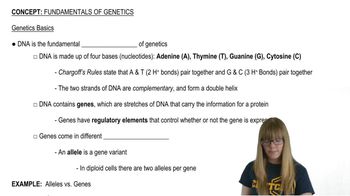Table of contents
- 1. Introduction to Genetics51m
- 2. Mendel's Laws of Inheritance3h 37m
- 3. Extensions to Mendelian Inheritance2h 41m
- 4. Genetic Mapping and Linkage2h 28m
- 5. Genetics of Bacteria and Viruses1h 21m
- 6. Chromosomal Variation1h 48m
- 7. DNA and Chromosome Structure56m
- 8. DNA Replication1h 10m
- 9. Mitosis and Meiosis1h 34m
- 10. Transcription1h 0m
- 11. Translation58m
- 12. Gene Regulation in Prokaryotes1h 19m
- 13. Gene Regulation in Eukaryotes44m
- 14. Genetic Control of Development44m
- 15. Genomes and Genomics1h 50m
- 16. Transposable Elements47m
- 17. Mutation, Repair, and Recombination1h 6m
- 18. Molecular Genetic Tools19m
- 19. Cancer Genetics29m
- 20. Quantitative Genetics1h 26m
- 21. Population Genetics50m
- 22. Evolutionary Genetics29m
7. DNA and Chromosome Structure
DNA Structure
Problem 1d
Textbook Question
How do we know that G pairs with C and that A pairs with T as complementary base pairs are formed?
 Verified step by step guidance
Verified step by step guidance1
Understand the chemical structure of the four DNA bases: adenine (A), thymine (T), guanine (G), and cytosine (C). Each base has specific sites capable of forming hydrogen bonds.
Examine the hydrogen bonding patterns: A and T form two hydrogen bonds, while G and C form three hydrogen bonds. This difference in bonding strength contributes to the specificity of base pairing.
Consider the molecular shapes and sizes: purines (A and G) are larger, double-ring structures, and pyrimidines (T and C) are smaller, single-ring structures. Complementary base pairs consist of one purine and one pyrimidine, maintaining a uniform width of the DNA double helix.
Review experimental evidence such as Chargaff's rules, which show that the amount of adenine equals thymine and the amount of guanine equals cytosine in DNA, supporting the complementary pairing concept.
Look at X-ray crystallography data of DNA, which reveals the spatial arrangement of bases and confirms that A pairs with T and G pairs with C through specific hydrogen bonding, stabilizing the double helix structure.
 Verified video answer for a similar problem:
Verified video answer for a similar problem:This video solution was recommended by our tutors as helpful for the problem above
Video duration:
2mPlay a video:
Was this helpful?
Key Concepts
Here are the essential concepts you must grasp in order to answer the question correctly.
Base Pairing Rules
Base pairing rules describe how nucleotides pair specifically in DNA: adenine (A) pairs with thymine (T), and guanine (G) pairs with cytosine (C). This specificity is due to the hydrogen bonding patterns and molecular structures, ensuring accurate DNA replication and stable double helix formation.
Recommended video:
Guided course

Base Distortions
Chargaff's Rules
Chargaff's rules state that in DNA, the amount of adenine equals thymine, and the amount of guanine equals cytosine. This empirical observation provided key evidence for complementary base pairing, showing a consistent 1:1 ratio between these bases across different species.
Recommended video:
Guided course

Genetics Basics
X-ray Crystallography of DNA
X-ray crystallography provided detailed images of DNA's structure, revealing the double helix and the specific pairing of bases. Rosalind Franklin's X-ray diffraction patterns helped Watson and Crick deduce that A pairs with T and G pairs with C, based on the molecular dimensions and hydrogen bonding.
Recommended video:
Guided course

X-Inactivation
Related Videos
Related Practice
Multiple Choice
Which of the following best describes a DNA molecule?
26
views


